The graduation or ranking of higher educational institutes like colleges or universities are evaluated on the basis of different criteria. The most important criterion is research criterion. Higher educational institutes need to collect staffs and students’ research publications, and also check their citations, h-Index, i10-Index and impact factors of journals. Even the evaluation committees like National Assessment and Accreditation Council (NAAC) expect higher educational institutes to give cumulative citation, h-index and i10-index, that is, research metrics. In order to get individual and cumulative research metrics like number of citations, number of citable documents, cites per document, h-Index and i10-Index, and impact factor of journals in an easy way, authors took the initiative to create Google Scholar profile of each faculty and then created Google Scholar account for the colleges adding links of all faculties’ on the Google Scholar accounts. This innovative new strategy will benefit higher education institutes appearing for NAAC accreditation or re-accreditation, or other ranking systems by the instructions, guidelines and steps furnished in this report.
In India, in the last decade, the numbers of universities and colleges have increased significantly. The latest statistics of higher educational institutes is 44 central universities (as on 15.1.16), 362 state universities (as on 29.6.17), 123 deemed to be universities and 260 private universities (as on 22.02.17), and a total of 11001 colleges, out of which, 9023 are under 2(f) and 12(B), and 1978 are under 2(f) but not included under 12(B) (as on 30.04.17), and 602 autonomous colleges, 150 Community Colleges and 66 academic staff colleges (as on 31.3.17) (University Grant Commission, 2017a-h). To evaluate or rank these institutions as per their performance and output, different agencies like National Assessment and Accreditation Council (NAAC), All India Council for Technical Education (AICTE), National Board of Acreditation (NBA) and International Organization for Standardization (ISO), and recently introduced National Institutional Rankings of Ministry of Human Resource Development Government of India were put in place to rank their performance.
All these agencies and bodies evaluate the higher educational institutes with regular frequency on the basis of their teaching, learning and resources, research, consulting and collaborative performance, graduation outcome, outreach, inclusivity and perception, etc. In the case of universities, they are ranked at national as well as international levels. At the national level, they can be ranked by NAAC, ISO and National Institutional Ranking Framework (NIRF), and there are few agencies that perform ranking of universities from all over the world every year by applying specific criteria and methodology like ‘Times Higher Education World University Rankings’, ‘QS World University Rankings’, ‘Centre for World University Ranking’ (CWUR), ‘World University Rankings’, ‘UI Green Metric World University Ranking’, ‘Kaggle World University Ranking’, ‘CWTS Leiden Ranking’, ‘University Ranking by Academic Performance’ (URAP), etc. In few cases, the university needs to be enrolled in the ranking system. Many un-enrolled universities are not evaluated in this system.
The most suitable ranking system which is ‘Webometrics Ranking of World Universities’ is an initiative of Cybermetrics Lab that takes into account a number of factors that are often overlooked in university rankings and other assessments like research, teaching, employability, internationalization, facilities, online/distance learning, engagement, innovations, culture, access and specialist criteria like excellence to claim world class status. Webometrics measure not only research output, including both formal (ejournals, repositories) publications and informal scholarly communication, teaching, the scientific impact of the university activities, but also, the economic relevance of the technology transfer to industry, the community engagement (social, cultural and environmental roles) and even the political influence. The common and most important criteria to evaluate higher educational institute by all agencies and bodies is research initiatives, ongoing funded research projects and research output of faculties and students.
To collect all information on this from all faculties and students followed by compilation and analysis is a tough task. Every higher educational institute appoints a committee for this criterion. This committee conducts review meetings, and they also ask faculties and students to send their publication list. There are many things the committee head needs to consider when calculating the total number of citations, h-index, i10-index and also impact factor of journals of all faculties, and then compile it to calculate the cumulative research metrics. Many institutes have their institutional repository that contains their faculty publications for reference purpose. But still, it is observed that not all staff or faculty members are expert in this type of analysis. Therefore, this study tried to provide simple techniques to face this criterion effectively in front of the committees with confidence and without much stress.
Objectives of this study
The main objectives of this study are:
1. To help all higher educational institutes to create and publish their cumulative research metrics.
2. To provide steps in creating institutional Google Scholar profile
3. To provide proper guidelines and precautions while creating cumulative research metrics and adding research publications.
Research is an academic activity. It is an “original independent” investigation undertaken to contribute to knowledge and understanding, and in the case of some disciplines, cultural innovation or aesthetic refinement (Kothari and Garg, 2014). According to Clifford Woody, research comprises of defining and redefining problems, formulating hypothesis or suggested solutions; collecting, organizing and evaluating data; making deductions and formulating hypothesis. It is an original contribution to the existing stock of knowledge paving way for its advancement. Research typically involves inquiry of an experimental or critical nature driven by hypotheses or intellectual positions capable of rigorous assessment by experts in a given discipline.
A research output
Research output is a particular dissemination, publication, presentation, communication or pathway in which research is made available to people other than the author. “Research outputs” (researchoutputs.auckland.ac.nz/default.html) is the system the university or higher educational institutes uses to record its staff research outputs and activities. Research output is divided into different categories like journal articles, conference papers/abstracts, poster presentations, chapters, working papers, thesis and dissertations, books, monographs, patents, compositions, internet publications, commentaries, editorials and confidential research output. Currently in many institutes, in-house repositories are being maintained using DSpace or E-Print Open Source Softwares. Many universities in developing countries give facility/platform/gateway to each and every students and staff to add their research output in institutional repositories. But still, these universities are not able to add all publications of their faculty and staff. It depends on the willingness of faculty or staff to share their publications or research output. Similarly in Indian higher educational institutes, it is also observed that not all faculties give their research output from time to time. Every higher education institute has their own policies and procedures to preserve and disseminate intellectual property created by their staff and students.
Citations
According to Maier (2015), a citation is when one paper explicitly refers to another paper, and in that paper full reference or cited paper is given in the bibliography. According to Wikipedia, a citation is an abbreviated alphanumeric expression embedded in the body of an intellectual work that denotes an entry in the bibliographic references section of the work for the purpose of acknowledging the relevance of the works of others in the topic of discussion at the spot where the citation appears. Generally, the combination of both in-body citation and the bibliographic entry constitutes what is commonly known as a citation. Citations are important for the following reasons:
1. Citations are how authors give proper credit to the work and ideas of others.
2. People also count citations of a paper as an indication of how important or influential the paper has been.
3. To avoid plagiarism, it is compulsory to give credit to the original author by citing his/her sources in references. Apart from plagiarism, citations are extremely useful to anyone who wants to find out more about the ideas and where they came from.
4. Citing sources shows the amount of research you have done and it strengthens your work by lending outside support to your ideas.
H-index
The h-index is an index to quantify an individual’s scientific research output (Hirsch, 2005). According to Wikipedia, the h-index is based on the set of researcher's most cited papers, and the number of citations that they have received in other people's publications. In calculating h-index, an attempt is made to measure both the scientific productivity and the apparent scientific impact of a scientist. On Google Scholar, the account of an individual researcher h-index shows the largest number h such that h publications have at least h citations at h times each. For example, a publication with five articles cited by 17, 9, 6, 3 and 2, respectively has the h-index of 3. The second column shows the recent version of the metric which is the largest number h such that h publications have at least h new citations in the last 5 years.
i10-index
i10-index is used only in Google Scholar, which is the number of publications with at least 10 citations. It is introduced by Google in 2011, and used to help gauge the productivity of a scholar. It indicates the number of papers an author has written that have been cited at least ten times by other scholars.
Google scholar
Google Scholar provides the search for all scholarly publications from many disciplines and sources like articles, abstracts, books, court opinions, from academic publishers, professional societies, online repositories, universities and institutions websites, patents, etc at one place and helps to find relevant work across the world of scholarly research. Using Google Scholar, we can explore related works, citations, authors and publications, locate complete document through the library or from the web, keep up with recent developments in any area of research using its advance search like year wise, including patents or citations options, keep tract of citations, get graph citations over time, check who is citing our publications and can create a public author profile free of charge. Google Scholar also compute several citation metrics like h-index, i10-index and also ranks the documents the way researchers do, provide details of each documents, where it was published, how often and how recently it has been cited in other scholarly literature.
Google Scholar profile of individual scholar
Individual scholar or researcher is able to create his Google Scholar account using his G-mail. To make it authentic and public, he or she needs to add authentic institutional email id and verify it. After adding personal details and profile picture, a research scholar is able to add his or her authored publications directly from the list that appears or manually. He or she needs to select multiple groups if he or she has written articles under different names, with different groups of colleagues, or in different journals. All the publications available online appears in the listed groups. Screenshot 1 is the Google Scholar profile of one of the staff of Modern College of Arts, Science and Commerce, Ganeshkhind, Pune, and India. The college has asked all staff members to create their Google Scholar Profile.
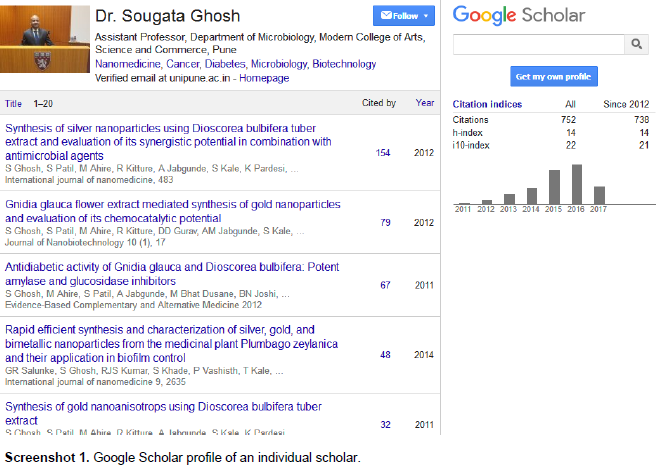
Research metrics of the higher educational institute
As discussed in the introduction part of this study, the common and most important criteria to evaluate and give ranking or grade to higher educational institute including universities, colleges and research institutes by all agencies and bodies is research and research output of faculties and students. The higher education institutes have Bachelors, Masters, Doctorate and Post Doctorate courses. In higher education system, teaching and research are complimentary to each other. Research enhances the quality of teaching/learning process. Involving students in research activity enables them to understand the truth and reality of a subject or topic taught to them in the class room. Therefore, research is an integral part of higher education (Pathan, 2005). It is expected from the higher educational institutes to create research culture among the faculty and students together with teaching.
Teachers should engage in research initiatives such as applying for funded projects, providing seed money for research initiatives, conducting seminars, symposia, workshop, conferences, providing support services for the faculty involved in research, deputing faculty to complete their research degrees and efforts to publish their research output in reputed journals and file patents. To obtain all information on this from all faculties and students, compelling and analyzing it is a tough task. Every higher educational institute appoints a committee for this criterion. These faculties’ conducts meetings, and also ask faculties and students to send their publication list (Stella, 2001). Most of the institutes classify and then compile the publications as a bound volume to present to the accreditation committee and
prepares list of publications as a compendium.
Google scholar for institutions research output
As discussed earlier, individual scholars can register on Google scholar using their Gmail, and create their research profile which gives their research metrics like number of citations, h-index, i10-index, citations per publications with their links and details. It provides them with an easy platform to add their new publications automatically, and intimate on them their new citations on their email. Herein, a strategy to use Google Scholar platform to create Institutional Research Metric was reported. Instead of individual research metrics, this strategy will enable the adding of publications of all faculties of the institutes in Google Scholar Account which will create Institutional Research Metric, that is, cumulative research metric like number of citations, h-index and i10-index of all faculties and researchers of that Institute at one place and can make it available for the public on their website too.
Prerequisites of creating Google Scholar account of an institute
Like individual Google Scholar account, to create Google Scholar account of an institute, the institute needs to follow these steps:
1. Appoint a staff to handle this responsibility, preferably from the research background.
2. Add information about an institute together with its affiliation and logo.
3. Add articles of staff members online or manually.
Appointment of responsible staff member to manage Google Account
Educational institution needs to assign this work to a senior staff that has research background and internet knowledge, and should be friendly with all staff members and students. Librarian or Research Committee member can be appointed for managing Google Scholar account of an academic institute.
Creation of Google Scholar account
In the case of Modern College of Arts, Science and Commerce, Ganeshkhind Pune, their librarian was appointed to manage the Google Scholar account. Using the library Gmail account, the college created the Google Scholar account. Once the Google Scholar is created there is need to add the Institution’s information like name, affiliation, areas of interest, and website along with college logo. Then, the Google Scholar account is verified with the office sending the official email id of the college. Screenshot 2 shows how the information and college logo are added to the Google Scholar profile of the college. The Google Scholar account email is verified with the official email id. Google Scholar checks whether the account is created by authentic persons and checks its genuineness.
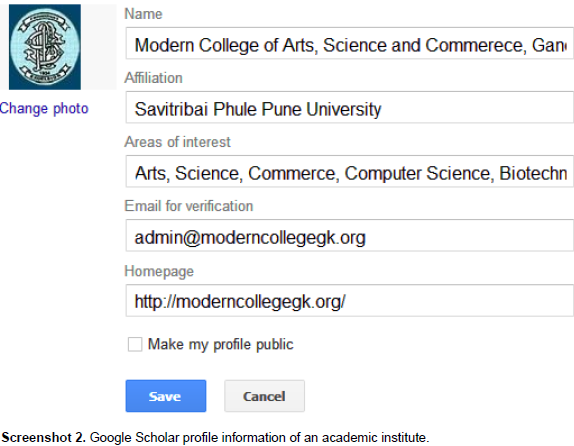
Adding publications
Before adding the publications of staff members, the Google Scholar account administrator should prepare a faculty publications list. Publications are added using add button. Here, example of addition of publications of academic staffs of Modern College of Arts, Science and Commerce, Ganeshkhind Pune are shown. Once option of add articles is selected, two options will be gotten. One in which, the online indexed article by staff members can be added directly by selecting from the bulk of articles under each staff member and the other is to add article manually. Screenshot 3 is an example showing how to fetch or link online indexed articles in Institution’s Google Scholar account. Here, the staff appointed to manage Google Scholar account should know which articles are written by the staff. For example, as seen in the image, the articles of scholars Varsha Shriram, Sanjay, S. Kharat and Vinay Kumar are displayed. Since Varsha Shriram is not a faculty member of Modern College, Ganeshkhind his articles should be ignored, and all the 28 articles by her should be removed.
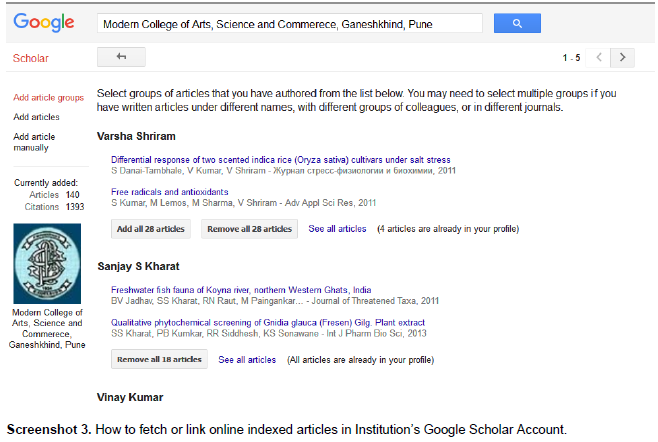
A total of 18 indexed article by scholar Sanjay, S. Kharat are displayed in Screenshot 4 which are already added, so one needs to check all articles one by one, and add the authored publication list of that staff. Only staff publications are selected. Google shows all articles with the name of the staff members and his co-authors too (Screenshot 5). Instead of add all articles, there is a need to click on see all articles and select one by one from the list. It is advisable not to make it public unless it is verified and complete. Once adding all faculty publications correctly is completed, then, college Google Scholar profile can be made public. Screenshot 6 is the sample of Google Scholar profile of Modern College of Arts, Science and Commerce, Ganeshkhind, Pune where it is updated regularly.
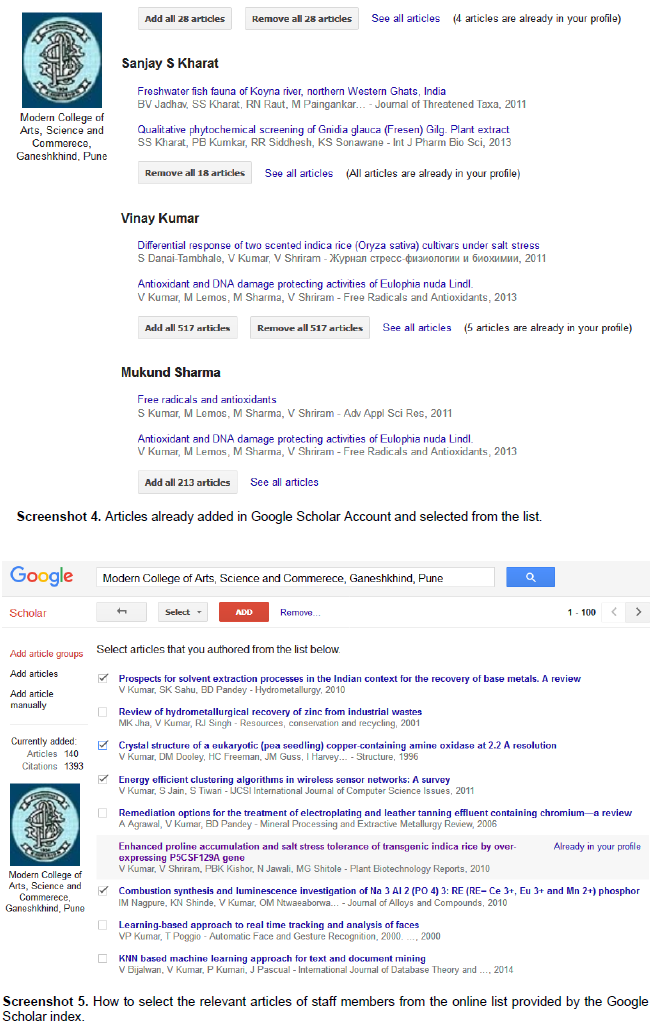
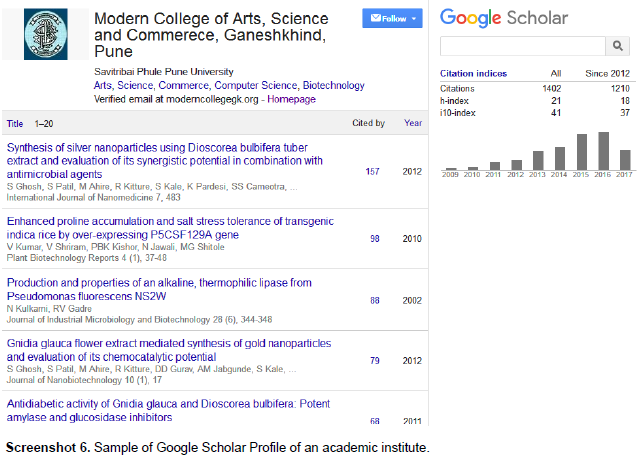
Publications as a bench marking system
As discussed in research output here in higher education system apart from teachers’ publications, there are lots of gray literatures available. Only patents and journal articles are covered in the Google Scholar. If an academic institution wants to increase its number of citations, h-index, and i10-index then they need to increase their number of publications. Here are few tips to increase publications and research metrics of the academic institutes.
Publishing gray literature
Institutes should publish selected assignments given to the students as mini reviews, commentaries, editorial column and short communications in the journals. The selected project reports of students can be published in journal article form or book form with some correction. Now, there is a practice of publishing conference and seminar proceedings in the form of book with ISBN or in a journal as a special issue. But academic institutions that are not able to do this still have option to publish the seminar or workshop or conference report in any journal. Current Science, University News publishes reports of seminar, conference and workshops are held in higher education. Teachers and students should publish their work in open access and indexed journals so that Google Scholar can fetch their publications and index them.
Publishing assignments of students
Institutes should publish the selected assignments of students either in Institutional repository or as mini reviews, commentaries, editorial, short communications, projects, workshop and seminar reports in journals like current science.
Publishing articles in open access and indexed journals
Articles published in open access journals and indexed journals gets more citations, and Google Scholar listed them to increase citation making it easy to add in Google Scholar profile of the institute, it is advisable to insist that staffs should publish their research work in open access and indexed journals.
Role of affiliation
Every faculty and student should mention their institution’s name as an affiliation. At times, staff members doing M. Phil and Ph. D from other universities should write the universities affiliation as Research Scholar. If faculty and staffs mention their institution’s name, then it becomes easy to add their articles in Institutions Google Scholar account, and they do not need to add it manually.
Name change
Many female faculty members and research students change their name after marriage. So Institutes should have data of both names. It is advisable for female staff to keep same name in all published papers. It will be useful to them in order to manage their individual Google Scholar account.
Research gate profile/Academia.edu profiles
It is advisable for all research faculties to create their research scholar profile of Research Gate of Academia.edusites where their publications are made available to all research communities, and it helps them to get more citations; also, these articles gets index in Google Scholar sometimes.
Open repositories/databases
There are many open repositories and databases available; so, research faculty and scholars can deposit their research output in those databases.
Benefits of Google Scholar
There are many benefits of creating Google Scholar profile of Institutes which gives cumulative research index like number of citations, h-index, and i10-index of all faculties. It helps in institutional growth and future planning, to get and apply for funded research and grant, for students placement, collaborative research, industry collaboration and International recognition, also, Google Scholar profile of an academic institution is useful. This profile is easily accessible to all faculties and public, but regular update is necessary.
Scope of departmental profile
Together with institutional, individual Google Scholar profile is a scope in which every department can create their own Google Scholar profile, and add all their departmental faculties research output. It gives the research index of that department, and help educational institute to check their research performance.